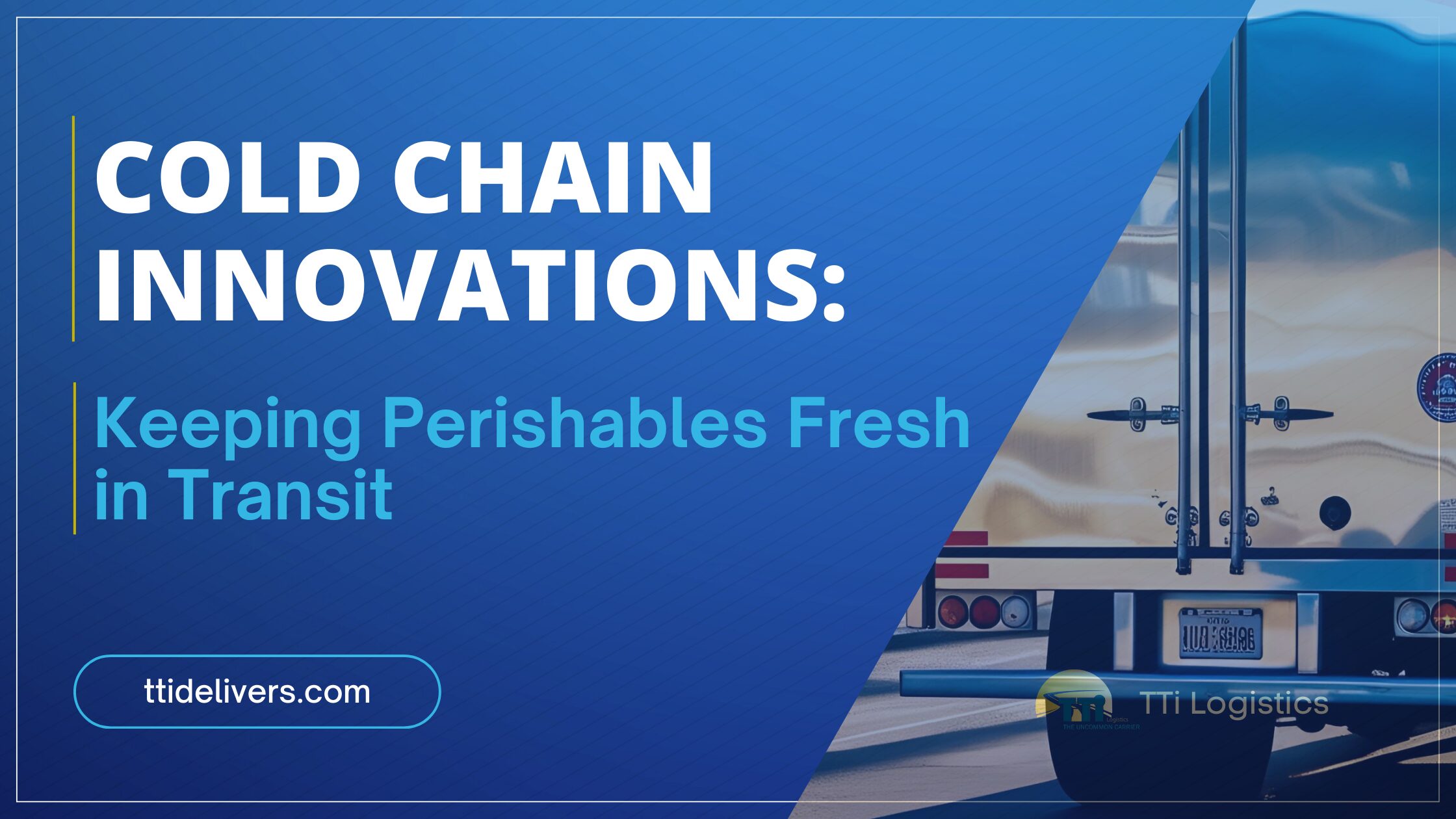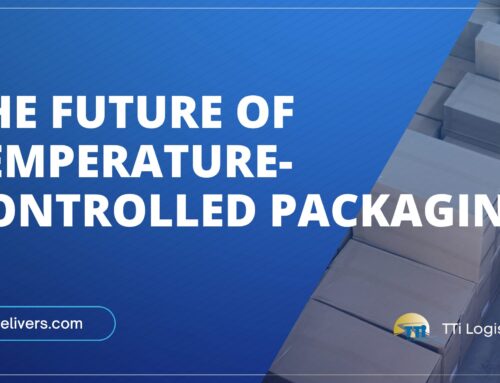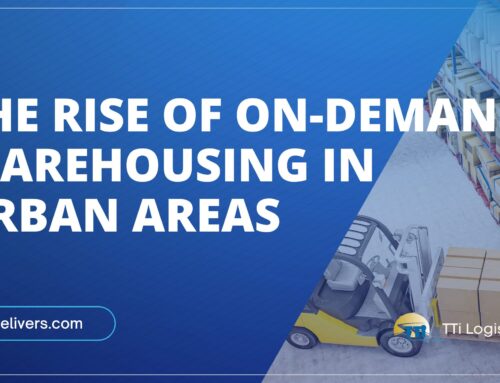The High Stakes of Temperature-Sensitive Shipping
When it comes to shipping perishable goods—like produce, pharmaceuticals, or fresh seafood—every degree matters. Even a slight deviation from ideal temperature ranges can result in spoiled products, lost revenue, and damaged brand trust. That’s where cold chain logistics comes in.
More than just refrigerated trucks, cold chain logistics involves a highly coordinated system of temperature control, packaging, tracking, and data management. And as the global demand for fast, safe delivery of perishables rises, so does the need for smarter, more resilient cold chain solutions.
At TTi Logistics, we work closely with clients who depend on these systems. Whether it’s a small batch of medical samples or a truckload of temperature-sensitive produce, our logistics strategies ensure freshness and compliance from point A to point B.
What Is Cold Chain Logistics?
Cold chain logistics refers to the transportation and storage of temperature-sensitive products using controlled environments throughout the entire supply chain.
This specialized branch of logistics is used for:
- Perishable food and beverages
- Pharmaceuticals and vaccines
- Chemicals and laboratory materials
- Floral products
- Certain cosmetics and electronics
Maintaining proper temperature throughout each stage—loading, transit, storage, and unloading—is critical to ensuring product safety and quality.
Key Components of a Cold Chain System
- Refrigerated transport (reefers): Insulated and climate-controlled trucks, containers, or vans
- Temperature-controlled storage: Warehouses with refrigerated or frozen zones
- Specialized packaging: Gel packs, dry ice, insulated liners, and temperature-monitoring devices
- Real-time monitoring: IoT sensors and tracking software that alert for any deviations
- Strict handling protocols: Standard operating procedures to prevent exposure to heat or cold
Why Cold Chain Logistics Is Growing in Importance
The global cold chain market is projected to surpass $800 billion by 2030—and for good reason. Several trends are pushing companies to prioritize cold chain logistics:
- Expansion of Global Food Supply Chains
Fruits, vegetables, meats, and dairy now travel long distances across countries and continents. As food sourcing becomes more global, the need for temperature-controlled logistics increases. - Rise of Pharmaceutical Shipments
With new medications, biologics, and vaccines requiring strict temperature conditions, the pharmaceutical industry is driving demand for advanced cold chain solutions. - Growth of Online Grocery and Meal Delivery
The explosion of e-commerce for perishable goods has created new expectations for freshness—even for same-day or two-hour delivery. - Stricter Regulatory Compliance
Health and safety regulations around temperature-sensitive goods are becoming more complex and demanding. Failure to comply can result in fines, recalls, and reputational damage. - Increased Focus on Sustainability
Reducing waste from spoiled perishables is both a cost-saving and eco-conscious goal. Smarter cold chain systems help companies cut down on discarded products.
Common Challenges in Cold Chain Logistics
Despite the advancements in technology, cold chain logistics is still one of the most complex areas in freight. The margin for error is slim, and the risks are high.
- Temperature Fluctuations in Transit: A broken reefer unit, a delayed shipment, or even prolonged door openings during loading can expose goods to temperature swings that compromise product quality.
- Inconsistent Cold Chain Infrastructure: Not all regions or partners have the same level of cold chain readiness. Inconsistent equipment, outdated facilities, or lack of training can lead to breakdowns in the chain.
- High Costs: Refrigerated shipping and storage require specialized equipment, trained staff, and energy-intensive systems—all of which come with a higher price tag.
- Lack of Real-Time Visibility: Without continuous temperature monitoring, businesses may not find out about a failure until it’s too late. Manual logs and outdated systems can leave major blind spots.
- Regulatory and Documentation Complexity: Each product category—and destination country—may have different compliance requirements. Failing to meet these can lead to customs issues, delays, or rejected shipments.
Innovations That Are Redefining Cold Chain Logistics
Thankfully, technology is rapidly transforming how cold chain operations are managed. Here are some of the most impactful cold chain logistics innovations making waves today.
- IoT-Based Temperature Monitoring
Wireless sensors now travel with each shipment and transmit real-time temperature data to the cloud. These systems offer:- Instant alerts for temperature breaches
- Detailed trip history and compliance logs
- Predictive analytics to identify weak points in the chain
- GPS and Route Optimization
Integrating GPS tracking with temperature data allows for smarter routing that avoids traffic, extreme weather, or delays that could impact perishability. - Advanced Packaging Materials
From phase-change materials to vacuum insulation panels, modern packaging is more efficient at maintaining target temperatures for longer periods. - Blockchain for Cold Chain Integrity
Blockchain allows multiple parties to record and verify temperature, location, and handling data throughout the chain—helping prevent tampering and improve traceability. - Autonomous and Electric Refrigerated Vehicles
Electric reefers and autonomous delivery vehicles offer more sustainable, efficient options for cold chain distribution, especially for urban and short-haul applications.
How TTi Logistics Keeps Cold Chain Shipments Safe and Efficient
At TTi Logistics, we recognize that managing temperature-sensitive goods isn’t just about having the right trucks—it’s about maintaining an unbroken chain of control, communication, and compliance from the moment a product leaves its origin to the time it reaches its destination.
End-to-End Visibility and Monitoring
Every shipment entrusted to TTi is tracked with real-time GPS and temperature data. Clients receive proactive updates and can access dashboards that show:
- Current temperature status
- Location and estimated delivery time
- Alerts if a threshold is exceeded
Customized Packaging and Prep Solutions
Not all cold chain products are the same. Frozen seafood, floral arrangements, and temperature-sensitive vaccines all have unique requirements. TTi provides tailored solutions including:
- Specialized containers and insulation
- Dry ice, gel packs, or thermal blankets
- Packaging audits to match carrier and route requirements
Dedicated Cold Chain Routes and Carriers
Our logistics network includes carriers with cold chain certification and specialized experience. We ensure:
- Refrigeration systems are properly maintained and calibrated
- Drivers are trained in cold chain handling
- Transit times are minimized and delivery windows are strictly managed
Contingency Planning
We build backup plans into every route. If a reefer unit malfunctions, if a route becomes impassable, or if weather delays affect a delivery, we:
- Activate alternate carriers or vehicles
- Redirect shipments to secondary cold storage hubs
- Communicate transparently with clients to adjust timelines
Preparation is everything in cold chain logistics—and we never leave that to chance.
Best Practices for Cold Chain Success
If your business relies on perishable or temperature-sensitive goods, partnering with a logistics expert like TTi is a great first step. But here are additional best practices to help you strengthen your cold chain operations:
- Define Clear Temperature Ranges: Know the acceptable temperature range for each product, and label shipments clearly for handlers and customs authorities.
- Document Everything: Maintain digital records of temperature logs, handling steps, and delivery milestones. This is essential for compliance, especially in pharma and food sectors.
- Invest in Smart Packaging: Work with providers who can match packaging to your transit time, temperature requirements, and route conditions.
- Train Your Team: From production to warehouse staff, make sure everyone handling your goods understands cold chain protocols.
- Test and Validate Your Routes: Conduct trial shipments or route audits to identify weak spots in the chain—especially when entering new markets or working with new partners.
Industries That Depend on Cold Chain Logistics
Cold chain logistics isn’t just for one sector. A growing range of industries now depend on these systems for both product safety and brand reputation.
- Food and Beverage: Perishable groceries, dairy products, meat, frozen meals, and beverages require consistent temperature control to meet safety regulations and consumer expectations.
- Healthcare and Pharmaceuticals: Vaccines, insulin, biologics, and medical lab equipment and samples must be kept at strict temperature ranges. Any deviation could compromise efficacy or patient safety.
- Floral and Horticulture: Fresh flowers and plants degrade quickly if exposed to heat. Temperature control extends shelf life and reduces waste during transport.
- Chemicals and Industrial Goods: Certain adhesives, inks, and chemical compounds are temperature-sensitive and must be kept within specific thresholds for safe handling and usage.
- Cosmetics and Personal Care: Products like organic creams, balms, or serums can separate or degrade under high heat—making cold chain essential for premium brands.
Looking Ahead: What’s Next for Cold Chain Innovation?
As technology continues to evolve, the future of cold chain logistics will likely include even more automation, intelligence, and integration.
- AI and Predictive Analytics: Expect smarter systems that not only monitor temperatures but predict risks—like potential reefer failure or weather-related route disruptions—before they happen.
- Drone and Autonomous Cold Deliveries: Urban last-mile cold chain solutions will increasingly include autonomous vehicles or drones equipped with mini-refrigeration units for quick, efficient drop-offs.
- Greater Regulatory Collaboration: Governments and logistics companies are working more closely to standardize compliance frameworks and prevent supply chain bottlenecks related to temperature-controlled goods.
- Blockchain for Transparency: More companies will adopt blockchain systems to create immutable records of cold chain handling—especially in pharmaceuticals and high-value goods.
- Carbon-Conscious Cold Chain Models: As sustainability becomes a requirement, companies will invest in lower-emission vehicles, green packaging, and optimized routes to reduce the carbon footprint of refrigerated transport.
Cold Chain Confidence Starts with the Right Logistics Partner
When you’re shipping products that depend on temperature precision, the cost of getting it wrong is too high to ignore. Spoiled food, damaged medicine, and lost revenue are just the beginning—the real risk is to your brand’s reliability.
That’s why TTi Logistics takes cold chain logistics seriously. With advanced monitoring, experienced teams, and a customized approach to every shipment, we help businesses protect their most sensitive products with confidence.
Want to explore how we can support your cold chain needs? Let’s connect and build a logistics plan that’s as reliable as it is innovative.







